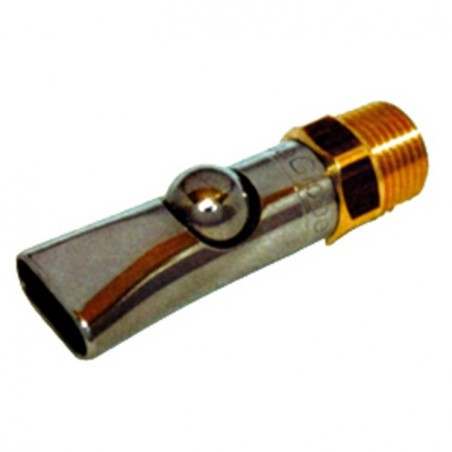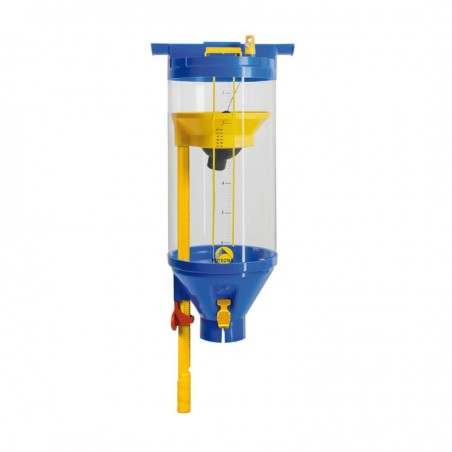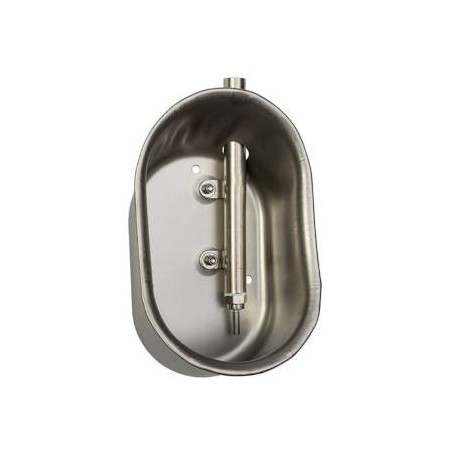Introduction
We are called in November 2014 for sudden mortality and neurologic symptoms on 70-kg fatteners. At the time of the call, the farmer had lost 3 pigs, and declared that he had noticed ataxia and weakness symptoms on other animals of the same batch.

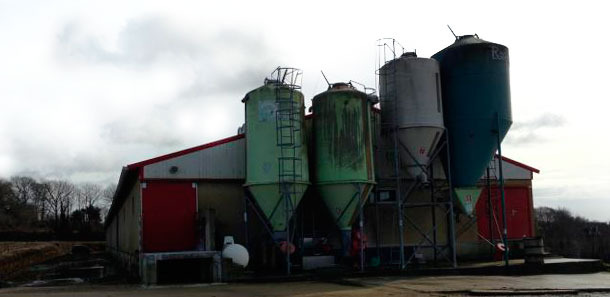
Farm description and context
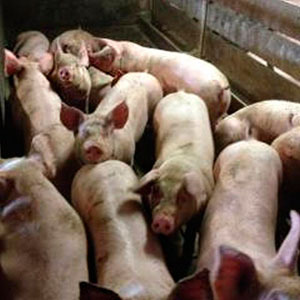 Pigs in the finishing unit in the farm |
The farm is located in a low-density pig area, in south-west Brittany. The farmer breeds only weaners and fatteners, which come from a newly established herd, with a very high sanitary level. The first piglets of this origin arrived on June 2014.
Piglets arrive at 3 weeks of age, just after weaning, every 7 weeks.
The weaning unit has a capacity of 400 piglets, and the fattening unit a capacity of 800 pigs.
Currently, piglets are only issued of gilts and primiparous sows.
The farmer is very rigorous concerning both external and internal biosecurity. Before the arrival of this new origin, the barns have been carefully cleaned and disinfected, and have remained empty for 6 weeks.
The health status of the herd of origin is described below:
- PRRSV: negative
- Actinobacillus pleuropneumoniae: negative for all serotypes
- Aujeszky’s disease: negative
- Mycoplasma hyopneumoniae: negative
- SIV (H1N1, H1N2 and H3N2): negative
- PCV2: vaccination implemented since the establishment of the herd
In August 2014, a monitoring of PRRS and Mycoplasma hyopneumoniae has been conducted on piglets: 10 pigs have been blood sampled 8 weeks after their arrival and have been found seronegative for both pathogens.
Since, no vaccination program has been implemented.
Feeding system:
Weaners are fed by granules feeders. Granules are bought to a feed factory.
Fatteners are fed with a soup distributed by a system of troughs. The soup is made of corn and wheat which are raised by the farmer, and a supplemental feed bought to another feed factory.
In the weaners unit, piglets are provided with water by nipple drinkers. In the fattening unit, water is supplied only by the soup meals, 3 times a day.
Clinical report (1):
In November 2014, 3 pigs were necropsied after they died suddenly, while other pigs in the same batch presented ataxia and weakness symptoms. Macroscopic lesions of those 3 pigs are listed in table 1.
| External lesions | Thoracic cavity | Abdominal cavity | |
| Pig 1 | None, well-formed subjects | Cardiac decompensation | Blood in small intestine, congestion of mucosa, oversized mesenteric and inguinal lymph nodes |
| Pig 2 | Fibrin deposition | Oversized mesenteric and inguinal lymph nodes, liquid and ochre-colored feces | |
| Pig 3 | Pericarditis, pleurisy | Oversized mesenteric and inguinal lymph nodes, grey-colored liquid feces |
Table 1: summary of first necropsies
First, macroscopic lesions evoked septicemia induced by a salmonella. Clinic matched with this hypothesis.
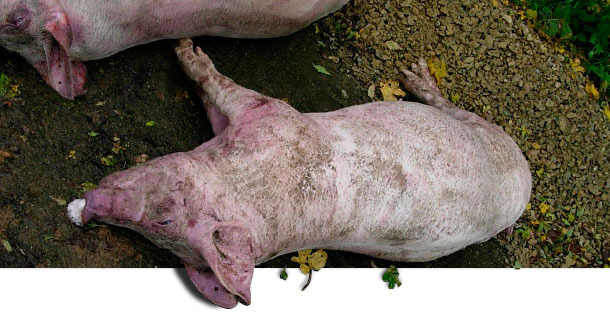
Dead pigs necropsied in the farm at the 1st visit
Mesenteric lymph nodes and feces sampled in the colon of each subject were sent to the lab to confirm this hypothesis.
Results were rather unexpected. In every sample:
- E coli O139K82 was identified from lymph nodes and feces swabs
- Virulence factors Stx2e and F18 were detected by PCR on E coli cultures
- Salmonella research was negative
Regarding the lab results, we concluded an Edema disease episode, which is extremely unusual at this age.
According to the antibiograms, all the usually-used molecules were effective on this E coli.
Clinical report (2): second wave of clinic
It was thus decided to fast the whole batch for 24h, and to orally treat them with colistin (100 000 UI per kg per day for 5 days), via water meals.
The treatment seemed to be efficient during the following week, but 2 weeks after, a second wave of mortality happened: 8 80-kg pigs, sudden dead or dead after presenting meningitis symptoms.
Clinic is still mild, according to the farmer. During the visit, we did not notice any sign of respiratory or digestive trouble, but pigs looked heterogeneous, some also presented ear necrosis, one with a dermatitis and nephropathy syndrome.
Losses were concentrated on 2 troughs, in 2 different rooms, and 3 pigs were seen presenting ataxia there.
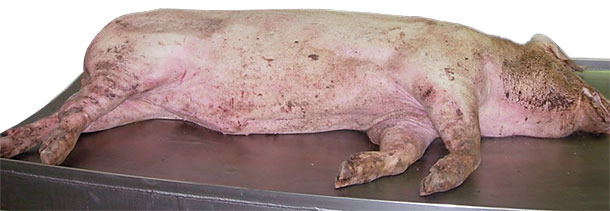
Dead pig necropsied and sampled at the 2nd visit
New necropsies were conducted on 80-kg pigs: macroscopic lesions were similar to the ones observed 2 weeks earlier.
One of the subject presented lung edema though, and each one presented oversized white lymph nodes (both mesenteric and inguinal).
New samples were sent to analysis, and same results came back: E coli O139K82 carrier of Stx2e and F18 virulence factors. Antibiogram showed the same sensitivity to antibiotics.
Thus, we were facing a second wave of edema disease. This is all the more surprising as both fasting and colistin treatment are usually very effective to deal with this pathology.
Clinical report (3): looking for inducing factors
Knowing the singularity of this case, we started to investigate some factors susceptible to induce Edema disease so lately:
- Coinfection agents, especially those which have immunosuppressive properties
- Ventilation issues
- Hygiene of water
- Perturbation of feeding
1. Coinfection agents
Regarding the lesions observed the second time and the concomitant clinical signs (heterogeneity, ear necrosis, dermatitis and nephritis syndrome), we suspected a PCV2 implication.
PCR research was consequently launched on:
- Lymph nodes of the latest pigs necropsied
- Sera of 15 blood sampled pigs of the batch, pooled by 5
Because of the absence of formalin at the time of the necropsies, no samples could have been kept for histology analysis. All the results were negative.
PRRS, SIV, Actinobacillus pleuropneumoniae, and Mycoplasma hyopneumoniae were not investigated as no evocative clinical signs had been noticed since the beginning of the Edema episode, or even before.
2. Ventilation issues
The farmer was no receptive to this point, arguing that he did not change anything in his equipment or in his ventilation management. However, cannibalism had already been noticed on animals of the former origins, as well as occasional signs of under-ventilation (ex: ammonia rate).
3. Hygiene of water
Bacteriology analysis was conducted after the second Edema episode. The sample was taken at the end of the water circuit, form a tap disinfected beforehand. Results are presented on table 2.
| Parameters | Sample | Norms* |
| Total coliforms | 0 g/ml | 0 |
| Fecal coliforms (E coli) | 0 g/ml | 0 |
| Fecal streptococcus | 0 g/ml | 0 |
| Sulphite-reducing anaerobic | 0 g/ml | 0 |
| Total bacterial count (22°C) | 0 /ml | < 100 |
| Total bacterial count (37°C) | 0 /ml | < 10 |
*Human consumption norms
Consequently, the water distributed to the animals was declared drinkable.
4. Perturbation of feeding
Pigs are fed with:
- 50% of corn
- 20% of wheat
- 30% of supplemental feeding, bought to a feed factory
First, corn was analyzed for mycotoxins. For a reason of costs, only DON (vomitoxin) was searched (ELISA method): 196 ppb were found. Table 3 lists the parameters analyzed on corn.
| Crude product | Dry product | |
| Humidity | 37.4 % | |
| Dry matter | 62.6 % | |
| Total nitrogenous matter | 5.2 % | 8.3 % |
| Starch | 44.7 % | 71.5 % |
Until then, the farmer added a salt intake to his feed. Animals were fed 3 times a day, with a soup composed of 2.7 kg of feed melt with 2.8L of water per animal. That means every pig receives 7.6 L of water every day, which could be restrictive on pigs over 80 kg (the objective is a water intake of 10% of alive weight [Massabie P, 2001], cf. table 4), especially when the NaCl intake is increased.
| Age | Weight | Consumption | Water intake |
| 70 d | 30 kg | 1.5 kg | 4.23 L |
| 90 d | 42 kg | 2 kg | 5.64 L |
| 110 d | 55 kg | 2.55 kg | 7.19 L |
| 130 d | 75 kg | 2.6 kg | 7.33 L |
| 150 d | 80 kg | 2.65 kg | 7.47 L |
| 170 d | 100 kg | 2.7 kg | 7.61 L |
After the second Edema episode, the farmer decided to increase the intake of acidifier (5kg/T of feed), and we managed to stop the NaCl intake.
Since, the situation got really improved despite slowed down growth on that batch: no more loss or nervous symptoms. No such clinical signs have been noticed by the farmer on the following batch.
Discussion
Edema disease is a quite common pathology in French farms. Most of the times, clinic signs and mortality happen on weaners, a few weeks after weaning [Moxley RA, 2000], sometimes on young fatteners [Fairbrothers JM et al]. Actually, no case of Edema disease has been reported on pigs over 70-80 kg in French farms, and no testimony has been found in international literature.
As many modifications were conducted at the same time (increase of acidifier intake, suppression of salt intake), no inducing factor could have been clearly identified, but we strongly suspect that a restricting water intake combined with a high salt intake to be responsible for the outbreak.
Moreover, ventilation issues have not been investigated, but a disruption of air flows is still possible.





